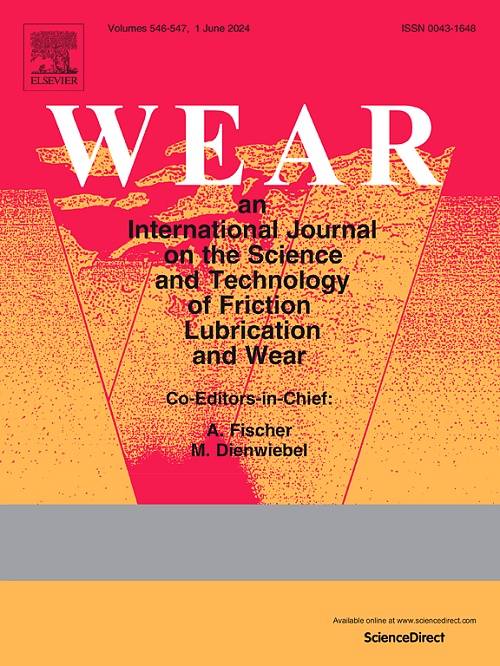不同滑滚工况下电力对ZDDP和MoDTC在低粘度油中牵引磨损特性的影响
IF 6.1
1区 工程技术
Q1 ENGINEERING, MECHANICAL
引用次数: 0
摘要
轴电流在电动汽车(EV)传动系统中非常常见,它会对轴承和齿轮的摩擦学性能产生有害影响。然而,对这种对润滑油牵引系数和磨损特性的影响的基本理解尚未建立。因此,本研究旨在阐明ZDDP和MoDTC等常用润滑添加剂与低粘度油(PAO4)混合在AISI 52100钢试验副上,在非电气化和电气化滑动滚动条件下的牵引特性。参数研究是使用电气化微型牵引机(MTM)在很宽的滑滚比和滚动速度范围内进行的,有和没有电气化。通过光学轮廓术、拉曼光谱和扫描电镜检查每组测试产生的磨损轨迹,以确定其磨损特性的关键差异。根据这些试验的结果,在接触界面上施加电会导致添加油的牵引系数发生实质性变化,并加剧了摩擦表面的磨料磨损的严重程度。在几乎所有的滑动-滚动工况下,电气化条件下的牵引系数也显著增加。含ZDDP的油受电影响最大,而只含MoDTC的油在通电条件下表现明显更好。MoDTC之所以能产生如此优异的效果,是因为在通电作用下形成了更有效的富mos2摩擦膜。本文章由计算机程序翻译,如有差异,请以英文原文为准。
Influence of electricity on the traction and wear characteristics of ZDDP and MoDTC in a low-viscosity oil under different sliding-rolling conditions
Shaft currents, which are very common in electric vehicle (EV) drivelines, can trigger deleterious effects on the tribological performance of bearings and gears. However, a fundamental understanding of such effects on traction coefficient and wear characteristics of lubricants has not yet been well-established. Accordingly, this work aims to elucidate the traction characteristics of common lubricating additives such as ZDDP, and MoDTC when mixed with a low-viscosity oil (PAO4) on AISI 52100 steel test pairs under non-electrified and electrified sliding-rolling conditions. The parametric studies were carried out using an electrified mini-traction-machine (MTM) over a very broad range of slide-to-roll ratios and rolling speeds with and without electrification. The resulting wear tracks from each set of tests were examined by optical profilometry, Raman spectroscopy, and SEM to identify the key differences in their wear characteristics. According to the results obtained from these tests, applying electricity to the contact interface causes substantial alterations in the traction coefficients of additized oils and intensified the severity of abrasive wear on rubbing surfaces. The traction coefficients also increased substantially under electrification in almost all the sliding-rolling conditions. The oils containing ZDDP were the most affected by electricity, while the oil containing only MoDTC performed remarkably better under electrified conditions. Such an outstanding effect enabled by MoDTC was attributed to the formation of a more effective MoS2-rich tribofilm under electrification.
求助全文
通过发布文献求助,成功后即可免费获取论文全文。
去求助
来源期刊

Wear
工程技术-材料科学:综合
CiteScore
8.80
自引率
8.00%
发文量
280
审稿时长
47 days
期刊介绍:
Wear journal is dedicated to the advancement of basic and applied knowledge concerning the nature of wear of materials. Broadly, topics of interest range from development of fundamental understanding of the mechanisms of wear to innovative solutions to practical engineering problems. Authors of experimental studies are expected to comment on the repeatability of the data, and whenever possible, conduct multiple measurements under similar testing conditions. Further, Wear embraces the highest standards of professional ethics, and the detection of matching content, either in written or graphical form, from other publications by the current authors or by others, may result in rejection.
 求助内容:
求助内容: 应助结果提醒方式:
应助结果提醒方式:


